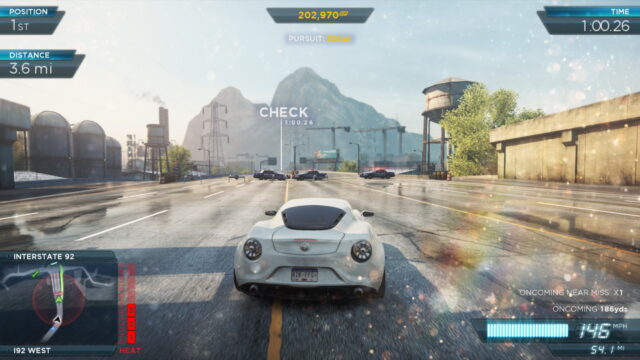
Need for Speed: Most Wanted (2012)
Written by: Rik
Date posted: June 10, 2022
- Genre: Racing
- Developed by: Criterion Studios
- Published by: Electronic Arts
- Year released: 2012
- Our score: 5
There’s no way around it: this is a game with the exact same name as one we’ve already covered, so we have to put dates in brackets after the title. Finally, it’s come to this. (It was a close run thing with the last Need for Speed developed by Criterion, Hot Pursuit, but its 1998 counterpart came from the days when they still put numbers in game titles).
While you could view the 2010 incarnation of Hot Pursuit as a remake of that late-90s effort, the two only shared the same common elements as many other Need for Speed games over the years: fast cars (an ever-present) and the police (in and out at various stages). I doubt anyone played Criterion’s Hot Pursuit expecting it to resemble a game from the late 90s in any way. It was a reboot: Electronic Arts saying, the franchise needs some new energy, so we’re giving it to a new studio to see what they can do with it.
Unfortunately, it all went so well for EA, they figured they could just repeat the trick with the same studio and another of the more popular instalments of NFS: 2005’s Most Wanted, developed by Black Box. Arguably, that was just another take on Need for Speed III: Hot Pursuit anyway – the first two Underground games featured no police chases at all, Most Wanted put them back in, and made them the focus, which made for a winning combination.
This 2012 Need for Speed game, also called Most Wanted, seems to have been conceived from a position of misunderstanding not only what the previous Most Wanted game was, but also Criterion’s achievements in delivering Hot Pursuit so successfully. Add into the mix EA’s abandonment of the studio’s Burnout franchise despite the strong critical and commercial performance of Burnout Paradise and you start to make sense of what we ended up getting here and why.
But, despite the VP of Criterion trying to talk about the original MW as if recalling a dim and distant gaming relic, these are two games released on the same generation of console hardware with seven years between them. MW (2012) feels like an awkward product, bearing a name that the publishers wanted but from which the developers probably wished to distance themselves. Where Hot Pursuit was a successful reimagining, Most Wanted is cursed by its associations, fighting with itself over what it wants to be.
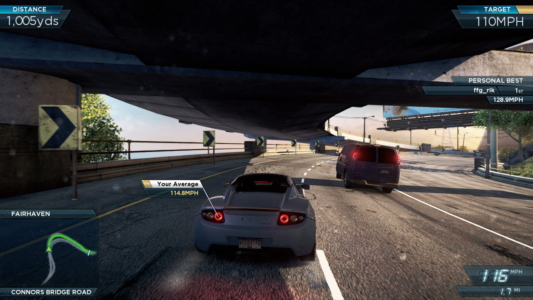
This is the first racer I’ve played to feature an electric car. Which is… good, I guess? Although it is a Tesla, and the lack of engine noise is kind of unnerving.
The story-based approach of the original has, unsurprisingly, been jettisoned, so there’s no more video cut-scenes of pouting rivals giving some context for the action. Instead, the 2012 iteration aims at a too-cool-for-school vibe, stripping things back to remove the focus on the drivers and place it on the cars, with car-porn introductory sequences supplemented by a disembodied female voice telling you how the various menus work.
The structure is far from complicated: you access races available for your current car via the D pad (this menu system is known as ‘EasyDrive’) and complete them to earn upgrades for that car as well as XP towards overall progress. Meet certain milestones, and you unlock a boss race against a ‘Most Wanted’ opponent. Aside from being able to win cars from these opponents, there are various others dotted around the city for you to find, hop into, and use at any time (unless they’re paid DLC cars, of course, and you want to pay EA more than the game itself costs to unlock them).
So there’s streamlining here: no story, no need to wait to unlock half-decent cars, and the various upgrades available after winning each race are clearly signposted. Win all of a car’s races, and it’ll be fully upgraded. You’re certainly never lost with regard to what to do next, and everything seems more fluid than a linear grind through various levels of progress. Races are easily restarted, and although you have to drive to the starting line the first time around, you can then jump to those that you’ve previously attempted directly. An insistence that you will enjoy the open world the developers have lovingly created by driving everywhere yourself has been relaxed since Burnout Paradise.
In theory this all sounds like progress, but from an early stage something just doesn’t quite sit right. While Hot Pursuit was technically an open map, it was a world of wide roads, long straights and bends to drift around, well-suited to the way the cars handled and an improvement over the chaotic crash-and-bash action of Paradise. Here, it’s like they’ve tried to recreate the inner city action of the 2005 game but without checking whether the driving model was up to it. There are a million things to crash into – traffic, walls, scenery – and you *will* crash into them, before getting the trademark Burnout auto-replay of the rolling car, smashed glass, and other debris in slow motion. It doesn’t take long to feel like you’re smashing through town like a drunken celebrity rather than a top street racer.
This extends to the racing itself, to a greater or lesser extent, depending on the route of that particular race, and whether the police are involved as well. There are certain contrived open spaces at junctions to allow you to powerslide across a tight corner, but there remains significant potential for accidents. As for the police, they take their usual psychotic approach to law enforcement, trying to smash you off the road and deploying series favourite tactics like spike strips and road blocks with a car-shaped gap in them, but without the full range of equipment featured in Hot Pursuit.
Otherwise though, they’re a curiously muted presence in the game and seemingly have nothing to do with becoming the ‘Most Wanted’ racer. The police roam the open world and appear in races, including Ambush challenges where you have to effect an escape from heavy police attention within a set time limit (during which the ideal route to take is usually pretty obvious, so that you’re able to put a bit of distance between your car and the pursuers before heading off road to hide), but there’s little need to antagonise them and lead them on a chase to build up your reputation, as before. Crucially, your capture and arrest fails to incur any noticeable penalty at all. Indeed, after the end of a race it can sometimes be the easiest way to reset rather than going to the effort of having to lose them.
In fact, it’s not altogether clear whether it’s the racers or the cars that are ‘Most Wanted’ here, and in place of the hyper-camp cut-scenes of the 2005 incarnation pitting you against Razor and his cast of actor-slash-models on the so-called Blacklist, there’s just another slightly faster car to race against once you meet the XP requirements. There’s no ongoing heat levels, no long chases that get out of hand as a result of trying to stir up trouble, and, sorry to say, no real tension. You’re not going to have your car impounded here.
The rest of the racing is a mixed bag. The best moments come when you get out onto the highway and you’re reminded of Hot Pursuit. There are some good timed and speed challenges too. But otherwise it’s a crash-fest: slow-motion replay after slow-motion replay, followed by miraculous resets. It would be even more annoying if such blundering caused you to lose races, although multiple smashes are no serious obstacle to victory, even if those victories obviously then feel rather hollow. There’s intended to be an element of strategy to your car setup, with different tyres and body kits supposedly offering trade-offs regarding performance and durability, and it’s true you may want to put off-road tyres on for certain races, but otherwise it doesn’t seem to matter that much.
Elsewhere, bits of Burnout Paradise seem to have been sneakily reintroduced, to no great effect: garages that instantly repair and change your paint colour on the fly, contrived jumps through billboards, and the need to ‘shut down’ your Most Wanted opponents in the open world after beating them in order to win their car. It does feel as if Criterion were a bit miffed about having to abandon their successful Burnout games in order to work on EA’s other racing series, and so decided to make this a kind of sequel, while trying to maintain some links to the source material.
There are three main problems here. One is that the racing is only intermittently exciting, and is very short-lived, with the career mode clocking in at 7 hours or so (there could be all kinds of exciting online opportunities I guess, and that definitely seems to be the emphasis, but for the solo player, that’s all there is). Two is that the constant crashing reaches a level of pantomime farce, particularly when you get onto the inevitable supercars, the Paganis and Koenigseggs of this world which seemingly sit at the summit of every arcade racer’s career mode. What happens when you drive at 190mph in an inner city space? Well, there’ll be a lot of accidents, of course. The end of each race is virtually a guaranteed pile-up, to the point where it goes past annoying and becomes vaguely amusing. And I won’t harp on about DLC, but there was one beautiful moment where I was chasing a Most Wanted racer in order to ‘shut him down’, only for him to race off into an area that I hadn’t paid for, causing my car to be crushed by big red crosses in the road.
Thirdly, almost all of the personality of the Black Box game has been completely ironed out. You can scoff at the silly cut scenes (and I did) but they added that scuzzy 00s street racing vibe, gave you some context for why you needed to be the ‘Most Wanted’, and a story to go along with the action. Razor took your ride, and tried to take your girl (who wasn’t actually your girl, but let’s not get into it), and you had to battle your way through hundreds of races and police chases in order to get your own back. Here it’s like, oh, you know, go and be ‘Most Wanted’ if you like, whatever that actually means.
To be fair, while Black Box led a successful reinvention of Need for Speed in the 00s, eventually they kind of ran out of ideas for what to do next: we got neon sci-fi, an unsuccessful attempt to move onto the track and an undercover cop adventure, before the series was passed into other hands. While 2003’s Underground took a slightly middle-aged concept and made it more contemporary, once that street racing angle got old, where else was there to go with it? Back to Jeremy Clarkson territory again. Hell, even the edgy try-hard music is gone, and now we have Muse playing over the introduction sequence. I don’t mind Muse, but I’m a 40-year-old man. Even ten years ago, I was too old to be the target demographic for this game. If you’re licensing music that I recognise and like, then you’re being lame. Bring back the rock and rap that might at least give me a headache and make me feel something.
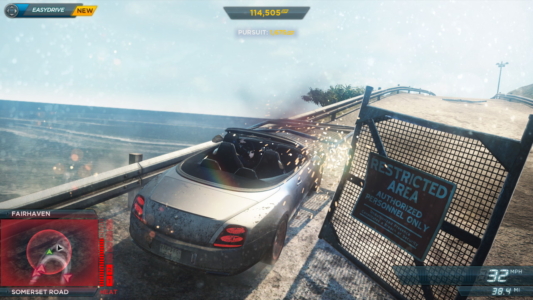
Restricted ACCESS? Authorized PERSONNEL? Authorize THIS, muthafucka, I’m the 10th Most Wanted car/driver in Fake City! [You mean Fairhaven – Ed.]

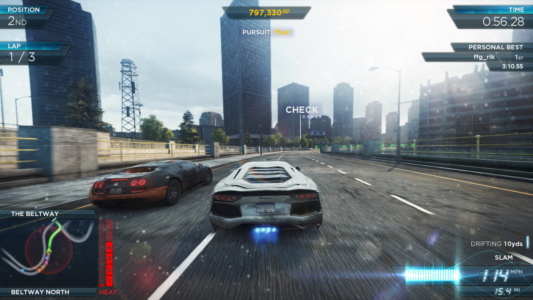
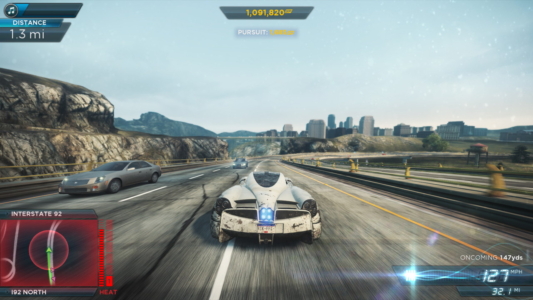
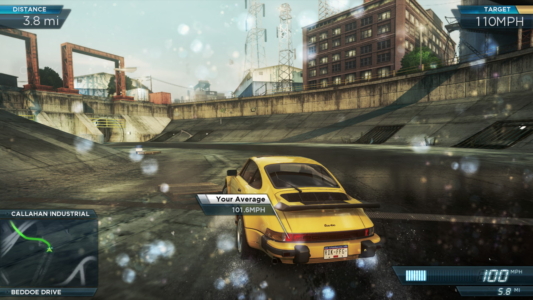
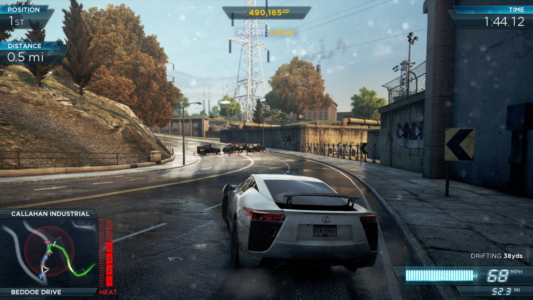

 Posts
Posts
Hi Rik,
Finally, this game has reached the 10-year mark to be torn apart on this site!
I first played it, like, 5 years ago on PS3. It seemed to me that everything, EVERYTHING, was completely wrong with it. I had a session for a couple of hours hours, then thought I’d had enough.
I must say that, at one point, I thought it was my particular predisposition to prefer the original from 2005, but your review has silenced all my doubts.
Tastes are tastes, sure, but the Muse band are a bad choice for this game. And I can’t stand Muse.
I think it’s time to fish out the Hot Pursuit remake or the original Most Wanted.
By the way, I recently finished The Run – as soon as I can, I’ll leave a comment on that.
Thanks for the article and have a good weekend!
June 10, 2022 @ 11:57 am
Hi Oleg, hope you’re well.
I must admit to being surprised by this one, especially considering how good Hot Pursuit was. I thumped through it easily enough, as with many previous slightly-iffy instalments, but that feeling of things not being quite right is there from the start, and gets worse as you progress.
Hope you enjoyed The Run. It’s not perfect but I found myself coming back to it and finding plenty to like (as well as plenty to not like).
June 11, 2022 @ 10:27 am